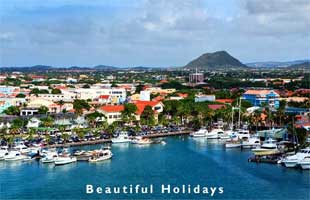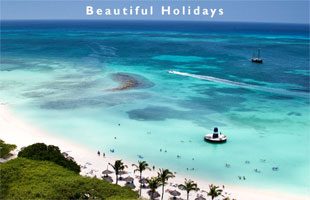Aruba Holidays Guide
The Caribbean

Aruba, part of the Netherlands, is a 33 km-long island in the Lesser Antilles, located in the southern Caribbean Sea about 27 km. north of Venezuela. The climate is dry and desert-like,and the island lies outside of the hurricane belt.Aruba's tropical marine climatetempts visitors to the island 365 days each yearwhere the calm southwest coast is dotted withextravagantresorts and charming retreats. Aruba is one of the five top windsurfing destinations in the world, due to a combination of flat-water spots, wide-ranging shallows,crazy waves, and trade winds that average up to fifteen knots; these strong warmwinds attract kite surfers and wind surfers from around the globe. Game fishing is excellent here, with catchincluding sailfish, blue and white marlin, dorado, wahoo, shark, barracuda, kingfish, bonito, amberjack, and black and yellow fin tuna.

Map of Aruba
Aruba Holidays Planner
Unlike other Caribbean islands, Aruba is covered with cactus plants rather than palm trees and tropical vegetation. It is warm, balmy, and the perfect destination to just rest, relax, and recover from the rat race. You won't find crowds of spring-breakers or beach bunnies here, and the cost to stay is relatively reasonable for the Caribbean. That's not to say there isn't plenty to do, though. Aruba is considered by many to be the wreck-diving capital of the Caribbean; the whole southern coast is a long coral reef,with more than twenty popular dive sites festooned with colourful coral and tropical fish, and eleven diver-friendly wrecks to explore.If you love the sea but aren't a diver, visit De Palm Island, where the waters teem with marine life, including the brilliantly blue parrotfish, found only in Aruba. The Sea Trek adventure lets you walk twenty feet below the surface in zero gravity along a 375-foot-long path, with air safely delivered to you via an underwater helmet.
 Aruba-Port
Aruba-PortAruba Accommodation Guide
Oranjestad, the busy capital, does an excellent job of reflecting the island's history and diverse culture, and is a terrific place to just take a long stroll. You'll notice that the islanders have their own patoiscalled Papiamento,acreole languagealso spoken on nearby Bonaire and Curaçao thatblends words from Portuguese, West African languages, Dutch, and Spanish.International music festivals, cultural events, tournaments and regattas are held throughout the year here, and Carnival is a vivid and vibrantspectacular, with colourful costumes, and music that just sweeps you away.
 Aruba-Palm Beach
Aruba-Palm Beach The action, accommodations, and activities are generally found on the south coast, as the northern and eastern coasts lack the natural protection afforded the southern side, and sohave stayed largely untouched.Here you can hike around and find hidden,secluded coves, sand dunes, and a natural pool. Subterraneancaves and natural bridgeshave been carved out by crashing waves and boisterous seas, and strangerock formationscan be seen across the desert. Arikok National Park, a natural preserve of rugged trails and incredible historical sites, present a challenging hike into virgin landscapes.Also try to spend time in Aruba's second largest city, San Nicolas, which has some beautiful beaches and Charlie's Bar which has become an unofficial museum since the 1940s when divers started to hang their underwater discoveries on the walls.
 Aruba-Natural Bridge
Aruba-Natural Bridge